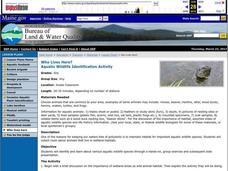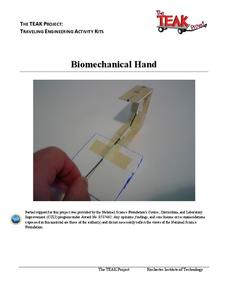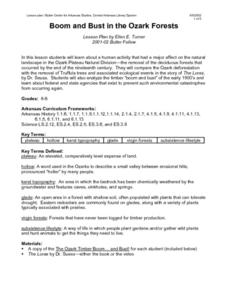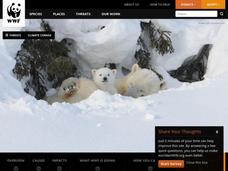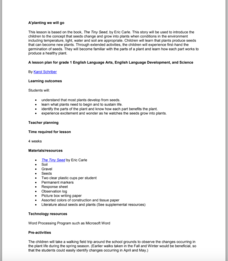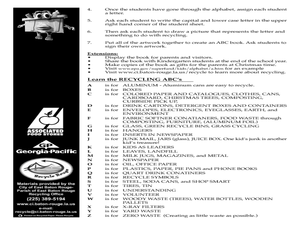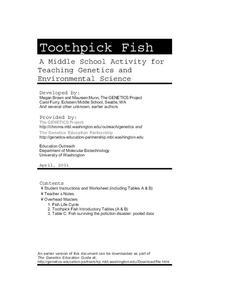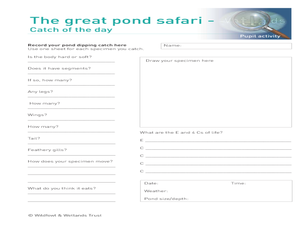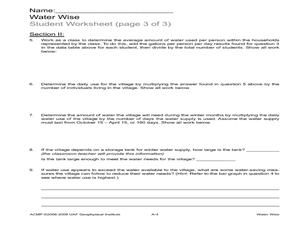Curated OER
Who Lives Here?
Learners identify various aquatic wildlife species. In this biology instructional activity students collect clues about animals that live in wetland habitats. Learners rotate through several stations displaying particular animal species...
Rochester Institute of Technology
Biomechanical Hand
In 1993, five biomedical engineers in Edinburgh, Scotland, created the first functional bionic arm. In the activity, learners explore the world of bioengineering through discussion and hands-on exploration. In groups, participants...
Curated OER
Boom and Bust in the Ozark Forests
Here is a hard-hitting, cross-curricular lesson on the effects that the deforestation of the Ozark forests in the 19th century had on the people, animals, and ecosystems of the area. The Dr. Seuss book The Lorax is used as a way of...
Curated OER
Climate Change And Disease
Students consider the role of climate change in the occurrence of vector born diseases such as malaria. In small groups, they research a specific vector to complete an information chart on climate changes in the region where the vector...
Curated OER
Water Pressure Blaster
Third graders complete an experiment to introduce them to the concept of water pressure. In this water pressure lesson plan, 3rd graders create pressure in a water bottle and observe the force of water that is created.
Curated OER
A'planting We will Go
Germination is an amazing process that results in amazing things. The book The Tiny Seed is the inspiration for a set of activities that will help build early literacy, observation, language, and writing skills. The class observes how...
Space Awareness
Greenhouse Effect
A greenhouse provides additional warmth and protection to the plants inside, but what if the greenhouse gets too hot? Pupils discuss and experiment with the difference between natural and anthropogenic greenhouse effect. They measure the...
Curated OER
Wetlands Are Wonderful
Students study the characteristics of wetlands. They are introduced to terms and different examples of wetlands. The hands-on activity reinforces the different parts of the wetlands, and provides a working model of a wetland.
Curated OER
Sound Busters
Fourth graders engage in a study of sound pollution at their school. After a class discussion on what noise pollution is, learners are asked if they think there are areas of their school or community where noise pollution is a problem....
Curated OER
Disasters (Natural & Man-made)
Students chose a natural or man-made disaster, such as a tornado or an oil spill, to research using the assigned web sites. They choose a presentation type from a list which includes poetry, radio broadcasts, and safety brochures, to...
National Wildlife Federation
The Amazing Adventures of Carbon: How Carbon Cycles through the Earth
Here's a stat for your pupils: 18 percent of the human body is carbon! Part 10 in the series of 12 takes pairs on an adventure through the carbon cycle. After a class reading about carbon, pairs read and choose their own adventure...
Curated OER
The Chesapeake Bay in Captain John Smith's Time
When Captain John Smith visited the Chesapeake Bay in the summer of 1608, what types of animals and habitats did he encounter? Your young historians will analyze primary source documents to answer this question, as well as compare...
Curated OER
Exploring Ecosystems
Students examine the relationships between plants, animals, and the environment in ecosystems. They sort animal cards, collect natural materials from the schoolyard, and record an ecosystem web in the form of a poster.
Curated OER
The Great Kapok Tree by Lynne Cherry
With The Great Kapok Tree, by Lynne Cherry as the hook learners discuss the rainforest, the animals that live there, and conservation efforts. Then, students write a letter to the man in the story asking him not to cut down the Kapok...
Curated OER
The Recycle Alphabet
First graders recognize words associated with recycling. In this environmental instructional activity, 1st graders go through the alphabet and think of words associated with recycling that start with a letter. Students create a recycling...
University of Washington
Toothpick Fish
With colored toothpicks representing genes, youngsters practice passing them through generations of fish and learn about heredity. Consider this as an introductory activity since it does not represent recessive genes with lowercase...
Curated OER
Recycling: The Way to Save...Fad or Fact
Pupils write stories about recycling and illustrate them. They examine various containers and determine whether or not they are recyclable. They make a chart about the containers and visit a recycling center.
Curated OER
Changes Over Time
Sixth graders identify and classify changes in their lives. During the second instructional activity students record observations of Blue Palo Verde seed pods and predict changes over time leading to further investigations.
Curated OER
Pond Safari
Young scholars investigate organisms and animals by examining a nearby pond. In this ecosystem lesson, students participate in a field trip to a local pond where they utilize a net to gather animals, plants and pollution items, Young...
Curated OER
Renewable Resources: Ancient Civilizations
Learners examine how ancient people used natural resources. In this renewable resource lesson, students will be put into 5 groups each focusing on a different past civilization. Each group will identify they types of resources their...
Curated OER
Water Wise
Students calculate their family's water consumption. In this water usage instructional activity, students discuss the water they use in their homes. Students complete the 'water wise' worksheets to tally their family's use of water....
Curated OER
Water and Sanitation
Students examine water contamination problems. For this global studies lesson, students compare and contrast water sanitation issues on Malawi, Tanzania, and Ontario. Students propose solutions to the water sanitation problems.
Curated OER
Invasive Species
Students study exotic and native species, and examine how exotic species can impact native ones. They study how the mute swan effects native species.
Curated OER
Working Animals
Students examine the need for the humane treatment of animals. In this animal welfare lesson, students realize the need for animal welfare, and decide on a service project that will promote it. The lesson culminates in the creation of a...
